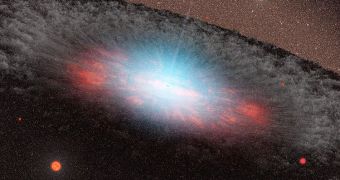A team of researchers in the United Kingdom believes it may have discovered a new type of black holes, after they were able to confirm the presence of an ultra-bright object in a nearby galaxy.
The group, which was led by experts based at the University of Leicester, also included scientists from the United States and France, SpaceRef reports.
The study researchers, who are all authorities in their respective fields, say that the peculiar object represents the most extreme ultra-luminous X-ray source they have ever seen.
This is what made the team argue that the object is the first of an entirely new class of black holes. The X-ray source that started it all is called HLX-1.
The object lies an estimated 300 million light-years from our planet, in the direction of the galaxy ESO 243-49, astronomers say. Subsequent observations have confirmed the amazing results.
The object is a factor of about 100 more luminous than most sources in its class, and about 10 times more so than the next brightest ultra-luminous X-ray source.
HLX-1 may therefore be an intermediate-sized black hole, a space construct which astronomers and astrophysicists alike have spent decades hunting for.
The Chile-based Very Large Telescope (VLT), which is operated by the European Southern Observatory (ESO), was used to measure the radiation emitted by the bright source.
One of the main things the researchers had to prove from the get-go was that the source was located within the target galaxy, and not in the background or the foreground.
After proving so, the astronomy was left with no other choice than to consider the fact that HLX-1 may be an intermediate-sized black hole.
In theoretical studies, these ultra-dense objects were shown to bet hundred to several hundred thousand times more massive than the Sun, but they were never actually found in real life.
“After our earlier discovery of the very bright X-ray source, we were very keen to find out just how far away it really is, so that we can work out how much radiation this black hole produces,” says Dr Klaas Wiersema.
“We could see on images taken with big telescopes that a faint optical source was present at the location of the X-ray source, located near the core of a large and bright galaxy,” the expert adds.
“We suspected that this faint optical source was directly associated with the X-ray source, but to be sure we had to study the light of this source in detail, using the Very Large Telescope in Chile,” he goes on to say.
“Much to our delight we saw in the resulting measurements exactly what we were hoping for: the characteristic light of hydrogen atoms was detected allowing us to accurately measure the distance to this object,” Wiersema adds.

 14 DAY TRIAL //
14 DAY TRIAL //